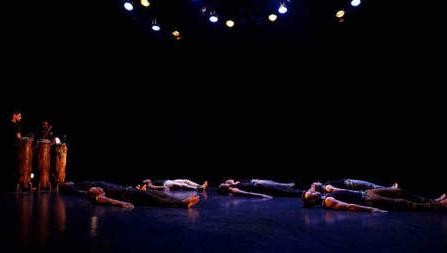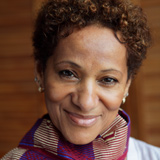First published in Rungh. Used with permission. rungh.org
 Mozongi by Zab Maboungou with Elli Miller-Maboungou,
Mozongi by Zab Maboungou with Elli Miller-Maboungou,
Adama Daou, Aboubacar Mané, Gabriella Parson, Karla
Etienne, Mithra Rabel, Jennifer Morse, Luis Cabanzo,
Raphaëlle Perreault, Le Gesù. November 2015.
Photo credit: Kevin Calixte.
When I received the invitation to participate in the great gathering that was Primary Colours this autumn in the city of Victoria in British Columbia, my feeling was above all that of remembrance. France Trépanier, Chris Creighton-Kelly, myself, and several others had already been there, in a way. We had experienced these gatherings, driven by the desire to see them turn into a pan-Canadian solidarity that could counter the effects of racial and cultural exclusion in our institutions and our communities. That was more than two decades ago… So what could we expect today?
The posture wasn’t one of scepticism, strictly speaking, but rather one of attention paid to time and to the resolution of the conflicts that assail us and divide us – us, human beings. To the time needed to learn not to know each other, but to “recognize” each other and to act together. Primary Colours wanted to give it a try and thus reactivate our ability to change.
And change was the issue. Not a hope for change, but change brought about since the actions of the past, that which could make this gathering a turning point, a sort of catalyst for the active presences on the territory and in Canadian society. That was the case, for the most part, thanks to our hosts from the traditional territory of the Songhees and Esquimalt Nations and the people of the Lekwungen Territory, in this city that today calls itself Victoria, but also thanks to the Indigenous participants who came from other regions, who were able to give this gathering all the meaning that we could expect: grounded and empowered, geared to the welcoming of another model of society.
For that, it had to be accepted freely and de facto by the elders as well as by the younger generations, who – another very positive aspect of this gathering – generously demonstrated on this occasion their involvement and their willingness to open themselves up to invent their own future.
The “continental” dimension of this event thus appeared to me, not to say that it was joyously embodied, and in a concerted manner, and with it, the “fluid” idea of a circulation of art and cultures.
Because that’s where we really came to an agreement: to reiterate and commit our strengths, whether it’s on the intellectual, aesthetic, activist and social levels, or on the levels of artistic practice, its transmission, and its distribution, beyond the usual definitions inherited from hegemonic practices which, for quite a long time already, have been granted the privilege of occupying space and producing concepts. This large-scale gathering, this Great Welcome, this multiplied dialogue, this collective imagining of decolonization, this decentralized diversity was not intended to reaffirm principles, even though this is always necessary in action, but to usher in a new stage, another New World.
Primary Colours has given itself the means to endorse what appears to be a vision, in the sense that Indigenous Peoples have always given it, that which is to lead us in an enlightened way towards what has already manifested itself.
A great welcome indeed

Zab Maboungou, named «Pioneer» of African Dance in Canada, is an artist and a philosopher who is a leader in the field of both dance creation and dance teaching. She is the founder of Zab Maboungou/Compagnie Danse Nyata Nyata (1986), a dance and music company that has been producing and creating Contemporary dance works for almost 30 years. The choreographer is also a writer and lecturer. Her book, "Heya…Danse! Historique, poétique et didactique de la danse africaine" expresses her commitment to allying art and knowledge and vice-versa. It has been said of her dance art that is enriched by the strength of her thinking and vision in the philosophical and cultural spheres in which she has become a recognised authority. With this international reputation in arts, research and teaching, her work as a performer, writer and lecturer has made a significant contribution to theory and debates about art and cultural diversity. Her expertise is sought in many places: universities and dance teaching centres, as well as various institutions, in Africa, Canada, the US, Europe and Asia.